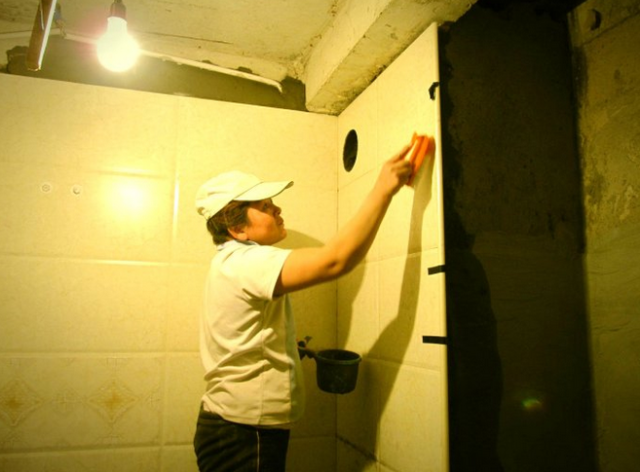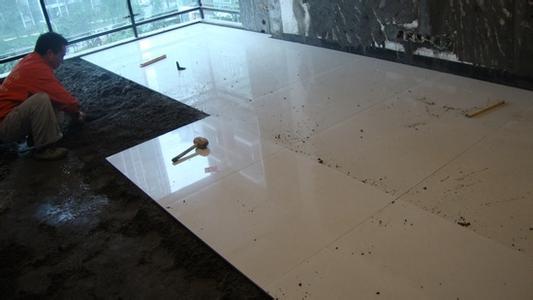 Experts said: “Generally speaking, owners are not advised to do so. The original wall itself is tiled and its surface is relatively smooth. Placing a new brick directly will cause the tile to have insufficient adhesion, and it will easily loosen and fall off. The owner intends to do this and there are three things to watch out for."
Experts said: “Generally speaking, owners are not advised to do so. The original wall itself is tiled and its surface is relatively smooth. Placing a new brick directly will cause the tile to have insufficient adhesion, and it will easily loosen and fall off. The owner intends to do this and there are three things to watch out for." 
 Three considerations
Three considerations  1 First, cement and mortar must not be laid on top of the original wall tiles, and the walls must be leveled. The surface of the original tile is polished to a very rough or uneven surface using a sander or other sanding tool, and then the cement mortar is prepared to a proper ratio for paving. Although this can reduce a certain amount of work, but the old tile itself has occupied the bathroom space when paving, the new tile will occupy a few centimeters more space on the original tile, the owner must take this into account when paving. From the effect of ensuring the long-term use of the tiles, it is recommended that the original tiles be removed and re-paved.
1 First, cement and mortar must not be laid on top of the original wall tiles, and the walls must be leveled. The surface of the original tile is polished to a very rough or uneven surface using a sander or other sanding tool, and then the cement mortar is prepared to a proper ratio for paving. Although this can reduce a certain amount of work, but the old tile itself has occupied the bathroom space when paving, the new tile will occupy a few centimeters more space on the original tile, the owner must take this into account when paving. From the effect of ensuring the long-term use of the tiles, it is recommended that the original tiles be removed and re-paved.  2 Second, although tile adhesives on the market can also bond new tiles to the surface of old tiles, the construction is relatively simple and clean. However, the bathroom is a damp space and the tiles tend to return to moisture. In this case, the use of tile adhesives may cause the tiles to fall out of the tiles, especially if the adhesive is not effective.
2 Second, although tile adhesives on the market can also bond new tiles to the surface of old tiles, the construction is relatively simple and clean. However, the bathroom is a damp space and the tiles tend to return to moisture. In this case, the use of tile adhesives may cause the tiles to fall out of the tiles, especially if the adhesive is not effective.  3 Third, because the old and new tiles are different in size, the gaps left are different. When the wall needs to be leveled, it is necessary to level the original gap and it will be very difficult to lay it. In addition to the old tile itself is empty, just use the tile adhesive to fix the new tile on its surface, which is easy to cause safety accidents. Because the bathroom needs to install sanitary equipment, you have to drill holes in the tiles. If the tiles are empty, you cannot carry heavy items. For example, the weight of hardware and mirrors can easily fall off for a long time and cause accidents. From the perspective of safety and paving effects, the original tile base was scraped off and re-paved. Although the construction was relatively troublesome, the paving effect and safe use were guaranteed.
3 Third, because the old and new tiles are different in size, the gaps left are different. When the wall needs to be leveled, it is necessary to level the original gap and it will be very difficult to lay it. In addition to the old tile itself is empty, just use the tile adhesive to fix the new tile on its surface, which is easy to cause safety accidents. Because the bathroom needs to install sanitary equipment, you have to drill holes in the tiles. If the tiles are empty, you cannot carry heavy items. For example, the weight of hardware and mirrors can easily fall off for a long time and cause accidents. From the perspective of safety and paving effects, the original tile base was scraped off and re-paved. Although the construction was relatively troublesome, the paving effect and safe use were guaranteed. Tiles experience exchange
Chlorinated polyethylene is a saturated polymer material with a white powder appearance. It is non-toxic and tasteless. It has excellent weather resistance, ozone resistance, chemical resistance and aging resistance. It has good oil resistance, flame retardancy and coloring properties. It is an excellent impact modifier for PVC plastics and a synthetic rubber with good comprehensive performance. It has a very wide range of applications and has been widely used in cables, wires, hoses, tapes, rubber and plastic products, sealing materials, flame retardant transport belt , Waterproof coiled material, film and various profiles and other products.
Chlorinated Polyethylene(CPE)
Chemical Chlorinated Polyethylene,Modifier Chlorinated Polyethylene,Cpe Chlorinated Polyethylene
Henan Shunbang Chemical CO.,Ltd , https://www.pvcresinchemical.com